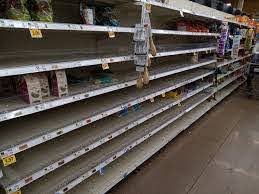Covid Crisis and Food
It’s no surprise that the emergency COVID-19 has created far reaching consequences. Many sectors in our modern economic and social system have been affected. One major consequence to social well-being is food, which involves production, distribution, and waste. Pre-Covid food waste projections estimate that somewhere between 25-40% of food grown and distributed in the US goes unused every year. This accounts for around $160 billion of waste annually. The problem of that much money and food being wasted cannot be denied. There are still many people who go hungry in the US every year. What’s more, the methane produced by food waste goes directly into landfills. Landfills are huge emitters of greenhouse gas and pollution. We know greenhouse gases to be a catalyst in climate change. For ore information on this topic, visit the US Department of Agriculture website. Unfortunately, Covid-19 is exacerbating the issue. We can see a drastic shift toward even more food waste. Harmony between farms, distributors, and traditional consumers (such as restaurants), is becoming increasingly difficult. Some tragic repercussions we are seeing include people out of work, and unable to provide for their families. However, one possible upside is that some major flaws in communications of the food industry are being exposed. Industrial-scale food loss is occurring in spades (pardon the pun). As our Bloomberg article states, “farms generally don’t sell directly to grocery stores, or to food banks, and changing distributors on the fly is tough.” What this means is that even with tons of food produced, there isn’t a streamlined process available to deliver that produce. However, these issues create opportunities for change.
Let’s End the Food Shortage
A solution to fix that gap in the distribution process is to pair “non-ideal” produce with buyers that don’t depend on the appearance of produce. Uses for “imperfect food” include making sauce or juice. One company based in San Francisco is pioneering this solution. A better distribution process demands a better relationship directly to farms. To accomplish this, farms would need to be more localized. To diversify away from monoculture, farms can instead forge relationships with the communities near to them. There are scattered places that have already begun trying this. We still need to see more businesses across the country to address the larger scale issue. Costs shifting during the pandemic will affect farmers trying to stay afloat. Solutions could come from a number of avenues. Through community supported agriculture (CSA), farm-to-table subscribers and the like wouldn’t rely so heavily on industrial scale distribution processes. The first roadblock to financial feasibility is the structure of subsidies. Most subsidy money goes to landowners rather than actual farmers. Also, pressure for farmers to produce huge quantities of items like soybeans, corn and wheat, makes it hard to take a localized approach. Ironically, most of this produce is ultimately used as feed for livestock. So, while we’ve got people going hungry, we are wasting food on livestock that require huge amounts of food. We have a system in desperate need of transparency and evolution. In a country of people who may need to radically shift the way we value food production and natural resources needed to grow food, we have lots of work to do. For more information on this topic, check out “Fixing the Covid Food Disaster Can Slash Climate Emissions” by Bloomberg.
Closing Thoughts
In this situation we really see the need for decentralization in the way we view food. Moving toward a more self-sustaining model would solve many of our food related problems. Currently, Beyond Energy Efficiency is collaborating on a “Farm-in-a-Box” product that would enable small communities to grow their own food. The Farm-in-a-Box requires less land and thusly has a smaller land footprint than most farms. We are also developing a business model to pair farmers with private families who want to grow fresh food. We wish to help the public attain the skills and knowledge to do so properly. Stay tuned for updates, and maybe consider turning some of your lawn into a farm. As we watch grocery prices climb, you may benefit from the food security.


Recent Comments